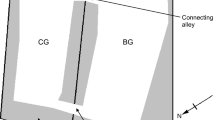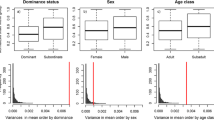Abstract
The spatial patterning and grouping behavior of domestic sheep (Ovis aries) under ranch management was studied. Activity was highly synchronized among flock members and was often initiated by several individuals, but no specific individual was always responsible. In the pasture, they were not randomly dispersed, but stayed together, and individuals did not develop specific favorite areas. They usually split into several groups. The size and composition of the group was very flexible and changed often. The group did not have fixed members, although there seemed to be certain partiality for an individual's association. In certain situations, the sheep sometimes formed a large flock composed of most members. They showed 2 types of flock formation: splitting into small groups, and assembling into one large group. They changed immediately from one formation type to another, without any particular individual's initiation. They seemed to have preference for association partners in a flock, but this was not found to be a determinant factor of subgroup composition. Furthermore a large group is not formed from the association of other stable subgroups. They seemed to be attracted by co-existence or the “flock” itself, rather than association with preferred individuals.
Similar content being viewed by others
References
Altmann, J. 1974 Observational study of behavior: Sampling methods.Behaviour 49: 227–267.
Arnold, G. W. 1983 Social interactions amongst beef cows when competing for food.Appl. Anim. Ethol. 9: 239–252.
Arnold, G. W. 1985 Spatial relationships between ewes and lambs.Appl. Anim. Behav. Scie. 14: 253–261.
Arnold, G. W. & M. L. Dudsinski 1978 Ethology of free-ranging domestic animals. Elsevier, Amsterdam.
Arnold, G. W. & A. Grassia 1982 Ethogram of agonistic behaviour for thoroughbred horses.Appl. Anim. Ethol. 8: 5–25.
Arnold, G. W. & P. D. Morgan 1975 Behavior of the ewe and lamb at lambing and its relationship to lamb mortality.Appl. Anim. Ethol. 2: 25–46.
Estes, R. D. 1974 Social organization of the African bovidae. In: V. Geist & F. Walther (eds.)The behavior of ungulates and its relation to management, Vol. 1. pp. 166–205. I. U. C. N., Morges, Switzerland.
Hafez, E. S. E. (eds.) 1975 The behavior of domestic animals (3rd edition). The Williams and Wilkins Company, Baltimore.
Imanishi, K. 1950 Social life of semi-wild horses in Toimisaki III: Summary for the three surveys undertaken in 1948–1949.Physiol. Ecol. Japan 3: 1–12. (In Japanese)
Kimura, D. & H. Ihobe 1985 Feral cattle (Bos taurus) on Kuchinoshima Island, southwestern Japan: Their stable ranging and unstable grouping.J. Ethol. 3: 39–47.
Ohta, I. 1982 Man animal interaction complex in goat herding of the pastoral Turkana.Afri. Stud. Monogr., Supplementary Issue 1: 13–41.
Scott, J. P. 1945 Social behavior, organization and leadership in a small flock of domestic sheep.Comp. Psyco. Monogr. 18: 1–29.
Shikano, K. 1982 Sociological study of the feral goats in Chichijima, Bonin Islands. Master's thesis, Kyoto University.
Shikano, K. 1986 The effect of pastoral nomadic monements on the goat herd cohesiveness. In: J. Tanaka (ed.)A study on human behavior and adaptation in arid area of Africa. pp38–42. Research group for the study on human behavior and adaptation in arid area of Africa, Hirosaki University, Japan.
Takasaki, H. 1981 DoesChrysozephyrus atrax oviposit at random?Satsuma 30: 131–137.
Tani, Y. 1976 On the pastoral culture: Interactions between the herder and livestock, and its metaphor.Zinbungakuho 42: 1–58. (In Japanese)
Author information
Authors and Affiliations
About this article
Cite this article
Kawai, K. The flexible grouping and behavioral character of a flock of Suffolk ewes (Ovis aries). J. Ethol. 7, 41–51 (1989). https://doi.org/10.1007/BF02350581
Received:
Accepted:
Issue Date:
DOI: https://doi.org/10.1007/BF02350581




